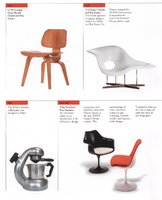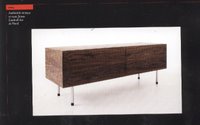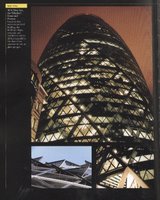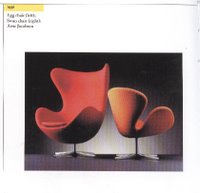Further into 50s design more
STREAMLINING came at the start of the 50s, but in my mind one of the most influencial movements. Coming from America, it had huge hold in their automotive design and childrens
toys. Streamlining with its aerodynamic appearance and seamless forms remains today, less designs but stunning designs.

(example of streamling applied today)
ORGANIC DESIGN was an influence throughout the 50s in the westerned world. With its sculpturing forms in natural and synthetic materials moulded around our outdoor surroundings.
Many of the memorable pieces of 50s design have elvolved from this movement.

(Organic design pieces)
INTERNATIONAL STYLE originated from the states and its approach was functionalistic on a stylistic level. An example is the iconic 50s side board, practical but also
esthetically pleasing. Another example is the roberts radio (I have one, love it). International style followed the same principles as good design, designing with general rules of design, with function and esthetics in right porportians to the object.

(a modern 2004 application of this movement, however the 1950s versions come under this movement too).
BIOMORPHISM, another movement that had its grip in the early 50s. A combination of natural forms and hightech materials. The most obvious form of this is the charles eames and
ray eams plastic chair (you know the one).

(a modern application of biomorphism-the Gherkin).
SCANDANAVIAN MODERN, my idea would be to 'think IKEA', bleach blond wood and bursts of color. Especially swedens version, came even before the 50s but has not left design to
this day.

(An egg and swan chair by Arne Jacobsen, an 1956 example of scandinavian modern).
CONTEMPORARY STYLE. Emerged from the UK with organic shapes and bright colours and heavily influenced not just our designs in the 50s.
All of these movements had an effect on what we know as 50s design, some more than others. However 50s design evolved on into something more eleaborate and bright in primarys
for the 60swhich, brough pop art, space age and op art. These expressive movements of the 60s would not have been so if design skiped the 50s nor if the 50s weren't the more
imnpacting decade for design change. We owe a lot to 50s design.
toys. Streamlining with its aerodynamic appearance and seamless forms remains today, less designs but stunning designs.

(example of streamling applied today)
ORGANIC DESIGN was an influence throughout the 50s in the westerned world. With its sculpturing forms in natural and synthetic materials moulded around our outdoor surroundings.
Many of the memorable pieces of 50s design have elvolved from this movement.

(Organic design pieces)
INTERNATIONAL STYLE originated from the states and its approach was functionalistic on a stylistic level. An example is the iconic 50s side board, practical but also
esthetically pleasing. Another example is the roberts radio (I have one, love it). International style followed the same principles as good design, designing with general rules of design, with function and esthetics in right porportians to the object.

(a modern 2004 application of this movement, however the 1950s versions come under this movement too).
BIOMORPHISM, another movement that had its grip in the early 50s. A combination of natural forms and hightech materials. The most obvious form of this is the charles eames and
ray eams plastic chair (you know the one).

(a modern application of biomorphism-the Gherkin).
SCANDANAVIAN MODERN, my idea would be to 'think IKEA', bleach blond wood and bursts of color. Especially swedens version, came even before the 50s but has not left design to
this day.

(An egg and swan chair by Arne Jacobsen, an 1956 example of scandinavian modern).
CONTEMPORARY STYLE. Emerged from the UK with organic shapes and bright colours and heavily influenced not just our designs in the 50s.
All of these movements had an effect on what we know as 50s design, some more than others. However 50s design evolved on into something more eleaborate and bright in primarys
for the 60swhich, brough pop art, space age and op art. These expressive movements of the 60s would not have been so if design skiped the 50s nor if the 50s weren't the more
imnpacting decade for design change. We owe a lot to 50s design.

0 Comments:
Post a Comment
<< Home